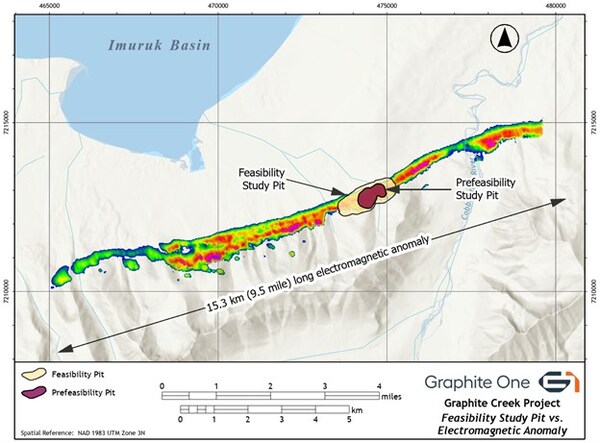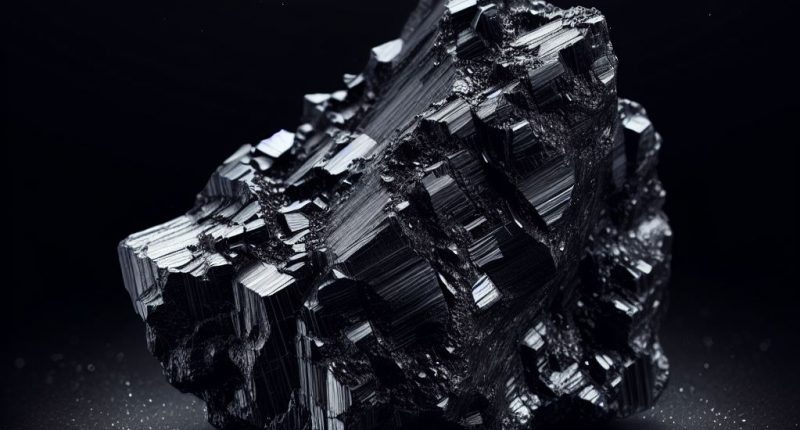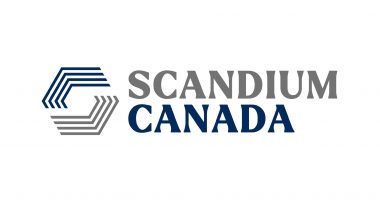Introduction
In an era marked by geopolitical uncertainties, including trade wars and potential military conflicts, the importance of securing domestic sources of critical minerals has never been more evident. Graphite One (TSXV:GPH) stands at the forefront of this effort, offering investors a unique opportunity to support and benefit from the development of a comprehensive U.S.-based graphite supply chain.
What is Graphite?
Graphite, a crystalline form of carbon, has garnered significant interest in the military sector due to its unique combination of properties. Known for its excellent thermal and electrical conductivity, high lubricity, and outstanding resistance to heat and corrosion, graphite stands out as a versatile material for various military applications. Its ability to perform under extreme conditions makes it ideal for components in advanced weaponry, aerospace engineering, and electronic warfare systems.
A report from the Hague Centre for Strategic Studies highlights that aluminum and natural graphite are the two most used materials in the defense industry. These materials are commonly found in a wide range of military hardware.
Graphite in military applications
Used in gun barrels, bolt carriers, and suppressors, graphite’s high lubricity significantly reduces friction and wear, essential for the longevity of gun barrels that endure high temperatures and pressures during firing. Graphite-based lubricants ensure smooth operation, reducing maintenance needs. This technology isn’t just theoretical – specific firearms with graphite components showcase improved accuracy, reliability, and extended service life, proving graphite’s practical benefits in the field.
In artillery and missile systems, graphite components play a pivotal role in enhancing performance and reliability. Graphite’s superior thermal management and electrical conductivity are crucial for missile guidance systems, ensuring precise and accurate targeting. In artillery, graphite is utilized in barrels and other critical components to endure the extreme temperatures and pressures generated during firing. This application enhances the durability and longevity of the equipment.
A vital component
Graphite is not only essential for renewable energy technologies but also plays a crucial role in military applications. The recent Executive Order titled “Immediate Measures to Increase American Mineral Production,” signed by the U.S. Administration in March 2025, drew a lot of eyes to this importance. This order tasks the Secretaries of Defense, Energy, and Interior with accelerating domestic critical mineral development, providing new government tools such as federal grants, loans, permitting reform, and offtake agreements.
Graphite One has welcomed this move, calling it the strongest signal yet of a ‘whole of government’ engagement to boost domestic mineral production. The expanded authorities of the Defense Production Act can support Graphite One’s initiatives, working to ensure a robust supply chain for advanced graphite materials.
Graphite One’s choice position
The Graphite Creek Project was designated a “High-Priority Infrastructure Project” by the U.S. Government’s Federal Permitting Improvement Steering Committee — the culmination of a process that began with the nomination on October 4, 2019, by Alaska Governor Mike Dunleavy of Graphite One’s project for priority status. Graphite Creek was determined to qualify for the high-priority designation under both the ‘manufacturing’ and ‘renewable energy’ sectors.
“The Graphite One deposit, the largest in North America, north of Nome, continues to move ahead with support from a Defense Department grant,” Governor Dunleavy told the Alaska legislators. “Construction could begin in that project by 2027 and the mine could be producing as early as 2029.”
With this federal determination, Graphite One can elect to list on the Federal Permitting Dashboard should the company choose to do so. The Federal Permitting Dashboard ensures that federal permitting agencies coordinate their project review authorities, resulting in a more efficient process, with more transparency for state agencies and the public.
Recent developments and government support
In January 2025, the U.S. Defense Logistics Agency released a video showcasing Graphite One’s project to develop an environmentally-friendly graphite-based firefighting foam. This project, funded by an agency grant, aims to replace the incumbent dirt-repellant per-and-polyfluoroalkyl substances firefighting foam used by the U.S. military and civilian firefighting agencies. This initiative is part of Graphite One’s broader strategy to leverage graphite for innovative technology applications beyond renewable energy markets.
Graphite One has also received significant support from the Department of Defense. Since 2023, the company has been awarded two grants from the department, including a US$37.5 million Defense Production Act Title III grant to accelerate the completion of the Graphite Creek Feasibility Study. This funding is a clear sign of how import graphite is as a battery material essential for national defense.
National security and supply chain independence
Given its use in renewable energy battery applications, energy storage devices, smartphones, laptops, and consumer electronics, as well as in commercial and military drone applications, developing a secure and independent domestic source of graphite — including its processing into advanced forms required for tech manufacturing and advanced weapons platforms — is a national security priority.
Since 2019, the buildout of lithium-ion battery capability has entered a new gear, with more than two hundred megafactories coming online worldwide since then.
Meanwhile, in 2020, the United States — with no domestic graphite production since 1990 — imported 41,000 tonnes of graphite materials. The bulk of that material comes from China, which not only leads global production but also processes the majority of the world’s coated spherical graphite (CSG).
In October 2024, Graphite One received a non-binding letter of interest from the Export-Import Bank of the United States for potential debt financing of up to $325 million through the bank’s domestic supply enhancement initiatives.
This potential financing points to the strategic importance of Graphite One’s project in mitigating the competitive impact of China’s dominance over global graphite production
Graphite One’s vertically-integrated supply chain
Graphite One’s plan is to build out a vertically-integrated U.S.-based supply chain capable of delivering 41,850 tonnes of battery-grade CSG, and 13,500 tonnes of additional advanced graphite materials annually. This has the potential to support critical supply chains and help the United States and its allies make up lost ground in the global battery arms race.
Envisioned as a vertically-integrated enterprise to mine, process, and manufacture high-grade CSG, the Graphite One Project would increase North American supply of high-purity CSG that meets or exceeds current requirements for electric vehicle battery anodes and other critical applications at a time when demand for graphite is skyrocketing.
Graphite Creek Property

The Graphite Creek Property, located on the Seward Peninsula in western Alaska, has been discovered to hold America’s highest grade large flake graphite deposit, with 37.59 million tonnes of measured and indicated resources at a grade of 5.14 per cent that could yield as much as 1,932,000 tonnes of contained graphite material.
Overall, an assumed 44 million tonnes of graphite mineralization at 7 per cent contained graphite available to be mined from the company’s Graphite Creek Property could support a project life of 23 years, producing 60,000 tonnes per year of graphite concentrate at 95 per cent graphite with an 80 per cent yield.
An owner-operated, year-long truck and shovel operation with four active mining areas, the Graphite Creek Mine would develop roughly 4 million tonnes of material each year, once full production is reached in Year 6. About 1 million tonnes, at an average graphite mineralization grade of 7 per cent graphite, would be delivered to the Mineral Processing Plant adjacent to the mine.
On an annual basis, the Mineral Processing Plant, estimated to operate 330 days each year, would reduce 1,018,000 tonnes of graphite mineralization to 60,000 tonnes of graphite at 95 per cent graphite, using multiple crushers and flotation circuits, as well as drying equipment. The dried concentrate would be shipped to the Port of Nome, stored, and barged seasonally to the Advanced Graphite Materials Manufacturing Plant.
The Mineral Resource Estimate for Graphite Creek was updated with data through the 2024 drilling program. The methodology used was the same as that described in the PFS. A lower cut-off grade of 2 per cent was used for the 2022 and 2024 resource.

Preliminary Feasibility Study results
The Preliminary Feasibility Study projects a net present value for the project on a pre-tax basis of US$1.93 billion using an 8 per cent discount rate, with an internal rate of return of 26 per cent.
On a post-tax basis, the net present value is projected at US$1.36 billion using an 8 per cent discount rate, with an internal rate of return of 22 per cent.
Advanced Graphite Materials Manufacturing Facility
Purification into CSG and other value-added graphite processing would occur at Graphite One’s proposed Advanced Graphite Materials Manufacturing Facility. The concentrate would be pelletized and thermally purified to at least 99.95 per cent graphite in high-temperature electric furnaces with a nitrogen atmosphere.
Once purified, the graphite would be air milled and turned into spheroidal shaped particles in 11 spheronizing machines. The resulting spherical graphite is then coated with a carbon pitch and heated in four carbonization furnaces to graphitize the coating.
At full production, and on an annual basis, the Advanced Graphite Materials Manufacturing Facility is expected to convert 60,000 tonnes of concentrate into 41,850 tonnes of CSG for end uses in electric vehicle and lithium-ion batteries as well as Energy Storage Systems. The remaining 13,500 tonnes per year of purified graphite powders will feed a range of other industrial and tech manufacturing supply chains.
Investor’s corner
In a world fraught with geopolitical tensions and trade uncertainties, Graphite One stands out as a strategic investment. The company’s comprehensive approach to developing a secure, vertically-integrated supply chain for graphite not only addresses critical national security concerns but also positions it to capitalize on the burgeoning demand for advanced graphite materials in both military and commercial applications.
Join the discussion: Find out what investors are saying about this stock on the Graphite One Inc. Bullboards and check out the rest of Stockhouse’s stock forums and message boards.
This is sponsored content issued on behalf of Graphite One Inc., please see full disclaimer here.
(Top image generated with AI.)





